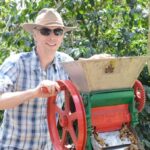

The third day of the Cafe Imports Barista Origin Trip kicked off this morning from the Outspan Hotel in Nyeri, Kenya as we all clambered aboard our souped-up LandCruisers and headed out for another day (and it should be noted our last day) exploring the coffee industry in this amazing country. Tomorrow we head back to Nairobi to catch a flight for the western part of Kenya in the Masai country for a two-day safari!

Speaking of this amazing country, we had a shorter day than our previous two as it is a national holiday celebrating 50 years of Kenyan independence. Last night there were fireworks at midnight and an ongoing concert and celebration from the capital was broadcast on the national television stations.

Our first stop this morning was the Ruarai Wet Mill. It’s a mill that works closely with SMS (Sustainable Management Systems) and we got to see firsthand how SMS’s training and education services have helped improve quality and production quality, primarily through organic fertilization, but also from dissemination of proper techniques of pruning, picking, processing, and more. The SMS model depends on locally elected trainers, who are selected by their fellow coffee farmers, to attend monthly classes and then pass what they’ve learned on to their local community.





We saw the wet mill operations which included some features I’d never seen before like a channel system (all feed by gravity) where water sorts the hulled coffee based on buoyancy then takes it down channels onto raised drying beds. The coffee is dried for only a couple of hours before it’s transferred into a curing shed, where the moisture content is further reduced. Then the coffee is taken out to traditional raised beds to complete the drying process.


After the tour of the facilities, we were treated to a snack of arrow root (dug from the nearby river banks, then boiled) which is claimed to be an excellent detoxifier. That is it can be helpful if you’ve had a little too much to drink the night before, and I suppose you can imagine how that might come in handy on such an adventure as this. We also had a couple of varieties of local bananas which were delicious and quite different from the standard store-bought version. We also had some freshly brewed coffee made from the mill’s supply.



Then we went to visit the farm of one of the SMS trainers for the Ruarai Mill. Mr. Obobo and his family met us by his house and we walked down the hill from the road into his field. He has 250 coffee trees which he inherited from his father, and he said that following the standards and procedures he learned from his SMS training he had been able to increase production and quality in his trees. Prior to the training, he said, each bush averaged around 3 kilograms of cherry, but now he was harvesting between eight and 10 kilos per tree.

Following the visit, we headed back to our hotel as most Kenyans were celebrating the holiday, and the baristas had an opportunity to explore the grounds and the nearby town before dinner tonight.

You can read about day 1 of the trip here, and day two here.

